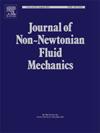Pairwise interactions of active particles in a yield stress fluid
IF 2.8
2区 工程技术
Q2 MECHANICS
引用次数: 0
Abstract
In this work, we numerically investigate the hydrodynamic interactions between two active particles (modeled as squirmers) in a Bingham yield stress fluid, and quantify the influence of the Bingham number and squirmer type on reorientation and scattering in face-to-face and crossing configurations. In the face-to-face configuration, increased Bingham number leads to greater reorientation of neutral and puller-type squirmers. In crossing interactions, yield stress suppresses the strong deflection observed in Newtonian fluids at small incidence angles. In contrast, for larger initial angles, the final separation angle between the squirmers is significantly increased in a yield stress fluid compared to that in a Newtonian fluid. To elucidate the underlying mechanism, we compute hydrodynamic torques on particles by constraining their orientations while allowing translation. In the face-to-face configuration, we find that yield stress amplifies the near-field torques on each particle, driving them to rotate away from one another and thereby increasing scattering. In the side-by-side configuration, yield stress qualitatively alters the sign and magnitude of the hydrodynamic torque on neutral and puller-type squirmers, reducing their tendency to rotate away and thereby favoring sustained parallel swimming. These results provide insight into the rheological behavior and transport properties of active suspensions in complex fluids.
屈服应力流体中活性粒子的成对相互作用
在这项工作中,我们数值研究了宾厄姆屈服应力流体中两个活跃粒子(模拟为蠕动子)之间的流体动力学相互作用,并量化了宾厄姆数和蠕动子类型对面对面和交叉构型中重定向和散射的影响。在面对面配置中,宾厄姆数的增加导致中性和拉杆型蠕动器的重新定向更大。在交叉相互作用中,屈服应力抑制牛顿流体在小入射角下观察到的强偏转。相反,对于较大的初始角,与牛顿流体相比,屈服应力流体中蠕动器之间的最终分离角显着增加。为了阐明潜在的机制,我们通过在允许平移的同时限制粒子的方向来计算粒子的流体动力扭矩。在面对面的结构中,我们发现屈服应力放大了每个粒子上的近场扭矩,驱动它们相互旋转,从而增加了散射。在并排配置中,屈服应力定性地改变了中性和拉杆式蠕动器的流体动力扭矩的符号和大小,减少了它们旋转远离的倾向,从而有利于持续的平行游动。这些结果有助于深入了解活性悬浮液在复杂流体中的流变行为和输运特性。
本文章由计算机程序翻译,如有差异,请以英文原文为准。
求助全文
约1分钟内获得全文
求助全文
来源期刊
CiteScore
5.00
自引率
19.40%
发文量
109
审稿时长
61 days
期刊介绍:
The Journal of Non-Newtonian Fluid Mechanics publishes research on flowing soft matter systems. Submissions in all areas of flowing complex fluids are welcomed, including polymer melts and solutions, suspensions, colloids, surfactant solutions, biological fluids, gels, liquid crystals and granular materials. Flow problems relevant to microfluidics, lab-on-a-chip, nanofluidics, biological flows, geophysical flows, industrial processes and other applications are of interest.
Subjects considered suitable for the journal include the following (not necessarily in order of importance):
Theoretical, computational and experimental studies of naturally or technologically relevant flow problems where the non-Newtonian nature of the fluid is important in determining the character of the flow. We seek in particular studies that lend mechanistic insight into flow behavior in complex fluids or highlight flow phenomena unique to complex fluids. Examples include
Instabilities, unsteady and turbulent or chaotic flow characteristics in non-Newtonian fluids,
Multiphase flows involving complex fluids,
Problems involving transport phenomena such as heat and mass transfer and mixing, to the extent that the non-Newtonian flow behavior is central to the transport phenomena,
Novel flow situations that suggest the need for further theoretical study,
Practical situations of flow that are in need of systematic theoretical and experimental research. Such issues and developments commonly arise, for example, in the polymer processing, petroleum, pharmaceutical, biomedical and consumer product industries.

 求助内容:
求助内容: 应助结果提醒方式:
应助结果提醒方式:


